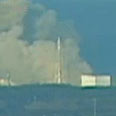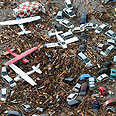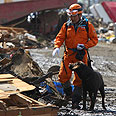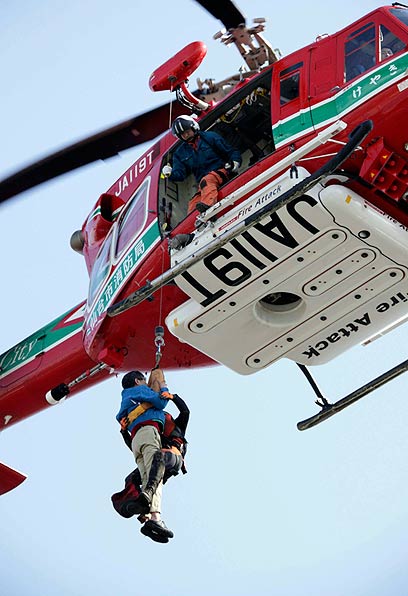




(VIDEO) An explosion at a nuclear power station Saturday destroyed a building housing the reactor, but a radiation leak was decreasing despite fears of a meltdown from damage caused a powerful earthquake and tsunami, officials said.
Government spokesman Yukio Edano said the explosion, in which two employees were reportedly killed, destroyed the exterior walls of the building where the reactor is placed, but not the actual metal housing enveloping the reactor.
That was welcome news for a country suffering from Friday's double disaster that pulverized the northeastern coast, leaving at least 574 people dead by official count.
The scale of destruction was not yet known, but there were grim signs that the death toll could soar. Ten thousand people were reported missing in the town of Minamisanriku alone according to a local TV channel
One report said four whole trains had disappeared Friday and still not been located.
Edano said the radiation around the Fukushima Dai-ichi plant had not risen after the blast, but had in fact decreased. He did not say why that was so. The pressure in the reactor was also decreasing after the blast, he said.
Japanese authorities have told the UN atomic watchdog they are making preparations to distribute iodine to people living near nuclear power plants affected by Friday's earthquake, the Vienna-based agency said.
Iodine can be used to help protect the body from radioactive exposure.
The explosion was preceded by puff of white smoke that gathered intensity until it became a huge cloud enveloping the entire facility, located in Fukushima, 20 miles (30 kilometers) from Iwaki. After the explosion, the walls of the building crumbled, leaving only a skeletal metal frame.
Tokyo Power Electric Co., the utility that runs the Fukushima Dai-ichi plant, said four workers suffered fractures and bruises and were being treated at a hospital.
"We have confirmed that the walls of this building were what exploded, and it was not the reactor's container that exploded," said Edano.
The trouble began at the plant's Unit 1 after the massive 8.9-magnitude earthquake and the tsunami it spawned knocked out power there, depriving it of its cooling system.
Mass destruction
The concerns about a radiation leak at the nuclear power plant overshadowed the massive tragedy laid out along a 1,300-mile (2,100-kilometer) stretch of the coastline where scores of villages, towns and cities were battered by the tsunami, packing 23-feet (7-meter) high waves.
It swept inland about six miles (10 kilometers) in some areas, swallowing boats, homes, cars, trees and everything else.
"The tsunami was unbelievably fast," said Koichi Takairin, a 34-year-old truck driver who was inside his sturdy four-ton rig when the wave hit the port town of Sendai.
"Smaller cars were being swept around me," he said. "All I could do was sit in my truck."
His rig ruined, he joined the steady flow of survivors who walked along the road away from the sea and back into the city on Saturday.
Smashed cars and small airplanes were jumbled up against buildings near the local airport, several miles (kilometers) from the shore. Felled trees and wooden debris lay everywhere as rescue workers coasted on boats through murky waters around flooded structures, nosing their way through a sea of debris.
According to official figures, 586 people are missing and 1,105 injured. In addition, police said between 200 and 300 bodies were found along the coast in Sendai, the biggest city in the area near the quake's epicenter.
The true scale of the destruction was still not known more than 24 hours after the quake since washed-out roads and shut airports have hindered access to the area. An untold number of bodies were believed to be buried in the rubble and debris.
Foreign aid pouring in
Meanwhile, the first wave of military rescuers began arriving by boats and helicopters.
Prime Minister Naoto Kan said 50,000 troops joined rescue and recovery efforts, aided by boats and helicopters. Dozens of countries also offered help.
President Barack Obama pledged US assistance following what he called a potentially "catastrophic" disaster. He said one US aircraft carrier was already in Japan and a second was on its way. Washington has also dispatched urban search and rescue teams, according to US Ambassador John Roos.
More than 215,000 people were living in 1,350 temporary shelters in five prefectures, or states, the national police agency said. Since the quake, more than 1 million households have not had water, mostly concentrated in northeast. Some 4 million buildings were without power.
About 24% of electricity in Japan is produced by 55 nuclear power units in 17 plants and some were in trouble after the quake.

45,000 people evacuated (Photo: Reuters)
Japan declared states of emergency at two power plants after their units lost cooling ability.
Although the government spokesman played down fears of radiation leak, the Japanese nuclear agency spokesman Shinji Kinjo acknowledged there were still fears of a meltdown.
A "meltdown" is not a technical term. Rather, it is an informal way of referring to a very serious collapse of a power plant's systems and its ability to manage temperatures.
Yaroslov Shtrombakh, a Russian nuclear expert, said a Chernobyl-style meltdown was unlikely.
"It's not a fast reaction like at Chernobyl," he said. "I think that everything will be contained within the grounds, and there will be no big catastrophe."
In 1986, the Chernobyl nuclear reactor exploded and caught fire, sending a cloud of radiation over much of Europe.
The reactor in trouble has already leaked some radiation: Before the explosion, operators had detected eight times the normal radiation levels outside the facility and 1,000 times normal inside Unit 1's control room.
Also before the blast, Ryohei Shiomi, a nuclear official, said that each hour the plant was releasing the amount of radiation a person normally absorbs in a year.
An evacuation area around the plant was expanded to a radius of 12 miles (20 kilometers) from the six miles (10 kilometers) before. People in the expanded area were advised to leave quickly; 51,000 residents were previously evacuated.
"Everyone wants to get out of the town. But the roads are terrible," said Reiko Takagi, a middle-aged woman, standing outside a taxi company. "It is too dangerous to go anywhere. But we are afraid that winds may change and bring radiation toward us."
Emergency situation
The transport ministry said all highways from Tokyo leading to quake-hit areas were closed, except for emergency vehicles. Mobile communications were spotty and calls to the devastated areas were going unanswered.
Local TV stations broadcast footage of people lining up for water and food such as rice balls. In Fukushima, city officials were handing out bottled drinks, snacks and blankets. But there were large areas that were surrounded by water and were unreachable.
One hospital in Miyagi prefecture was seen surrounded by water. The staff had painted an SOS on its rooftop and were waving white flags.
Technologically advanced Japan is well prepared for quakes and its buildings can withstand strong jolts, even a temblor like Friday's, which was the strongest the country has experienced since official records started in the late 1800s. What was beyond human control was the killer tsunami that followed.
Japan's worst previous quake was a magnitude 8.3 temblor in Kanto that killed 143,000 people in 1923, according to the USGS. A magnitude 7.2 quake in Kobe killed 6,400 people in 1995.
Meanwhile, the Foreign Ministry reported that it has yet to make contact with nine Israelis currently traveling in Japan.
A spokesperson on behalf of the ministry noted that the collapse of Japan's communications network made it more difficult to locate the nine, and expressed hope that they will all be contacted soon.
Ronen Medzini contributed to this report
- Follow Ynetnews on Facebook















